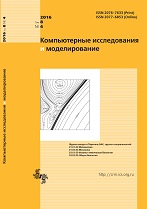|
This article is cited in 1 scientific paper (total in 1 paper)
MODELS IN PHYSICS AND TECHNOLOGY
High-speed penetration. Discrete-element simulation and experiments
K. K. Abgaryana, S. V. Eliseevb, A. A. Juravlevac, D. L. Reviznikovc
a Dorodnicyn Computing Centre, Federal Research Center “Computer Science and Control”
of Russian Academy of Sciences,
Vavilov st. 44, b. 2, Moscow, 119333, Russia
b Mechanical EngineeringResearch Institute,
Leningradskoye sh. 58, Moscow, 125212, Russia
c Moscow Aviation Institute (National research University),
Volokolamskoye sh. 4, Moscow, 125993, Russia
Abstract:
The paper presents the results of numerical simulation and experimental data on the high-speed penetration of the impactor into the obstacle. In the calculations, a discrete-element model has been used, based on the representation of the impactor and the target by a set of close packed interconnected particles. This class of models finds an increasingly wide application in the problems of high-speed interaction of bodies. In the previous works of the authors, the questions of application of the discrete-element model to the problem of the penetration of spherical impactors into massive targets were considered. On the basis of a comparative analysis of the data of computational and physical experiments, it was found out that for a wide class of high-speed penetration problems, a high accuracy of discrete-element modeling can be achieved using the two-parameter Lennard-Jones potential. The binding energy was identified as a function of the dynamic hardness of materials. It was shown that the use of this approach makes it possible to describe accurately the penetration process in the range of impactor velocities 500-2500 m/c.
In this paper, we compare the results of discrete-element modeling with experimental data on penetration of high-strength targets of different thickness by steel impactors. The use of computational parallelization technologies on graphic processors in combination with 3D visualization and animation of the results makes it possible to obtain detailed spatio-temporal patterns of the penetration process and compare them with experimental data.
A comparative analysis of the experimental and calculated data has shown a sufficiently high accuracy of discrete-element modeling for a wide range of target thicknesses: for thin targets pierced with preservation of the integrity of the deformed impactor, for targets of medium thickness, pierced with practically complete fragmentation of the impactor at the exit from the target, and for thick impenetrable targets.
Keywords:
high velocity impact, discrete-element model, binding energy, numerical simulation.
Received: 04.08.2017
Accepted: 29.09.2018
Citation:
K. K. Abgaryan, S. V. Eliseev, A. A. Juravlev, D. L. Reviznikov, “High-speed penetration. Discrete-element simulation and experiments”, Computer Research and Modeling, 9:6 (2017), 937–944
Linking options:
https://www.mathnet.ru/eng/crm109 https://www.mathnet.ru/eng/crm/v9/i6/p937
|

| Statistics & downloads: |
| Abstract page: | 253 | | Full-text PDF : | 102 | | References: | 47 |
|



 Contact us:
Contact us: Terms of Use
Terms of Use
 Registration to the website
Registration to the website Logotypes
Logotypes